Cambodia
 From Rationalwiki
From Rationalwiki _-_KHM_-_UNOCHA.svg.png)
“”Once you’ve been to Cambodia, you’ll never stop wanting to beat Henry Kissinger to death with your bare hands... Witness what Henry did in Cambodia – the fruits of his genius for statesmanship – and you will never understand why he’s not sitting in the dock at The Hague next to Milošević... While Henry continues to nibble nori rolls & remaki at A-list parties, Cambodia, the neutral nation he secretly and illegally bombed, invaded, undermined, and then threw to the dogs, is still trying to raise itself up on its one remaining leg.
|
| —Anthony Bourdain, A Cook's Tour.[1] |
The Kingdom of Cambodia, also known as Kampuchea, is a small state located in southern Indochina. Although Hinduism predominated for over 2,000 years and was the state religion in its glory days, with Mahayana Buddhism prevalent as well, starting in the 12th and 13th centuries Theravada Buddhism steadily displaced both; today the vast majority of its population, about 98%, practices Theravada Buddhism, which is the country's state religion.[2] The remaining people are mostly Muslims and Christians. Cambodia's government is an elective constitutional monarchy, and its monarch is selected by the nine-member Royal Council of the Throne.[3] Among the council members is the prime minister, who serves as the head of government; the current prime minister is Hun Manet![]() since 2023, succeeding his father Hun Sen
since 2023, succeeding his father Hun Sen![]() . Talk about nepotism!! Not to mention that his father who had reigned since 1985 and just resigned recently, has become just about everything he fled and fought against during the Khmer Rouge years. Cambodia's capital and largest city is Phnom Penh, which despite being only around 200 years old in any permanent form, is its political, economic, and current cultural center.
. Talk about nepotism!! Not to mention that his father who had reigned since 1985 and just resigned recently, has become just about everything he fled and fought against during the Khmer Rouge years. Cambodia's capital and largest city is Phnom Penh, which despite being only around 200 years old in any permanent form, is its political, economic, and current cultural center.
Once upon a time, Cambodia was a giant state called the Khmer Empire, which formed in 802 CE and ruled a big chunk of Southeast Asia for about 600 years. The Khmer Empire was heavily influenced by India's culture, and it facilitated the spread of Buddhism throughout the Indochina region. It also constructed many amazing architectural wonders, the most famous of which is Angkor Wat. Around the Fifteenth Century, Ayutthaya (proto-Thailand) revolted against Cambodian rule, and the Khmer state rapidly declined in power and eventually became a geopolitical irrelevancy and occasional footstool for Imperial China. In 1863, France conquered Cambodia and turned it into a heavily exploited colony.
France treated its Indochinese subjects quite badly, and they rose up against colonial rule both during and after World War II. Cambodia gained its independence in 1963, but it was constantly threatened by the Vietnam War raging next door. The United States futilely tried to hunt down Vietnamese communists, who were weaker but fought smarter and were willing to throw vastly more corpses at the situation. The Vietnamese communists built a supply trail through Cambodian soil, so the US secretly and illegally bombed the shit out of Cambodia between 1969 and 1973. A US-supported coup brought in a right-wing government headed by a total no-name that tried to force the Vietnamese out. However, the deposed Cambodian king and much of the Cambodian public decided to support the new government's most dangerous enemy: the Khmer Rouge. The Khmer Rouge won out in 1975, installed their leader Pol Pot as the country's dictator, and carried out the horrific Cambodian genocide that killed millions of people. Luckily, the Khmer Rouge were then ousted by the Vietnamese, who had won their own war.
What followed was a prolonged period of Vietnamese occupation and an insurgency fought by the Khmer Rouge. In 1991, the foes finally reached a peace accord, and the United Nations stepped in to help transform Cambodia into a somewhat functional country. The new government restored the monarchy as a figurehead. It established what is theoretically a multiparty democracy. However, in practice, Hun Sen is a candidate for the world's most corrupt leader, and the opposition parties are all centered around equally degenerate excuses for politicians. Since then, Cambodia has focused its efforts on rebuilding from its long period of destruction.
Historical overview[edit]

Early history[edit]
The earliest sapient homos presence in Cambodia dated 70,000 years ago. Archaeological evidence isn't conclusive as to how far back the human occupation of Cambodia goes. Still, it seems clear that the practice of rice farming spread throughout the region throughout the 3rd millennium BCE.[4] Like in other rice-farming areas like China and Bangladesh, rice proved to be the staple food item and contributed to rapid population growth. The Austroasiatic people migrated overland along the Mekong, from the Yunnan highlands to Southeast Asia around 2,000 BCE. They formed several ancient Neolithic settlement sites in northern Vietnam, Thailand, Laos, and Cambodia.
While Europe had its culture shaped by the Roman Empire, a similar but more peaceful process happened in Southeast Asia. In this case, India's vast population and powerful empires spread their political ideas and culture through trade with surrounding areas.[5] Early Cambodians never adopted the caste system, but they did adopt Indian ideas to establish centralized states, starting with the thalassocratic Funan Kingdom in the 1st century BCE.[5] As Funan became more notable on the geopolitical stage, their exposure to Indian culture accelerated due to Indians immigrating to Cambodia and diplomats arriving from the various Indian kingdoms. This serves as an interesting case study on how cultures and religions can propagate without the need for conquest or direct violence. Mahayana Buddhism and Hinduism arrived in Cambodia around the years of Christ and quickly became dominant.
Khmer Empire[edit]
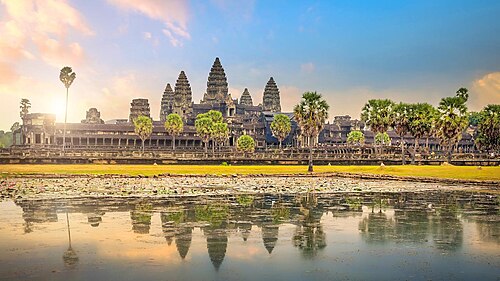
By the mid-6th century, the early state of Funan collapsed, and its successor state Chenla eventually gave rise to the state that undoubtedly represents Cambodia's cultural golden age. The Khmer Empire, founded in 802 CE, was an extraordinarily advanced civilization for its time. Its founder, Jayavarman II, started construction on many now-famous Angkor temples.[6] His successor, Indravarman I, ordered the construction of massive reservoirs and irrigation projects to facilitate rice growing. These projects and later ones freed farmers from relying on unpredictable monsoons and gave rise to an early "green revolution" that ensured significant rice surpluses and enabled rapid population growth.[6]
Like any other early state with a strong economy and growing population, the Khmer Empire started getting hungry for more land. It didn't take long for the Khmer to start biting big chunks out of their neighbors, starting with the Cham people and moving on to the Vietnamese.[6] Suryavarman II, who lived from 1113 to 1150, extended Cambodian rule from Vietnam to Burma. His greatest achievement was completing of the Angkor Wat temple complex, which is still an impressive construction to this day.[6] It is, in fact, the largest religious monument in the entire world.[7] Angkor, the capital of the empire, was probably the world's first megacity, as it snowballed to the point where it could have supported a population of at least one million people.[8] We'll remind you, this is a city built almost a thousand years ago.
Not everything was sunshine, roses, and cool buildings. Cambodian culture was rigidly hierarchical during this period. Its king was considered divine, and the people were his personal property to do with as he chose.[6] Next came the priesthood and some officials and nobles, and finally, the commoners, who were subjected to conditions that were little better than slavery. Below them were, of course, actual slaves, of whom there were very many. These slaves and commoners were the true labor behind the construction of Angkor Wat and other such structures. In addition, basic things like sanitation were rather lower than displays of grandeur on the city planner's list; as a result, dysentery was rampant in Angkor.
One of the most significant rulers of the empire, Jayavarman VII, who ruled from 1181 to 1218, converted from Hinduism to Mahayana Buddhism and went on a frenzied building spree to establish as many temples, roads, and hospitals as he could.[6] After his reign, Cambodia began the process of converting to Theravada Buddhism.

Phimeanakas temple.

Ta Keo temple complex.
.jpg)
Bakong temple.
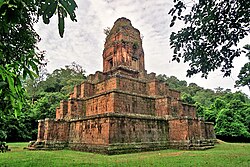
Baksei Chamkrong temple.
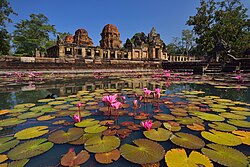
Muang Tam temple.

Phnom Rung temple complex.

Sikhoraphum temple.
Cambodian dark age[edit]

As described above, the Khmer Empire was a virtual slave society headed by and entirely dependent on a god-king. Not exactly a recipe for success once the good times end, and the good times ended. First, Mahayana Buddhism fell to the wayside as the population started to adopt Theravada Buddhism instead. The Theravada school preached self-reliance, self-improvement, and individualism.[9] The common people began to question their unquestionable king, and Theravada monks helped them by schooling them and teaching them to read.
Meanwhile, the Thais started revolting against Cambodian rule. In 1353, a Thai army destroyed Angkor, and about a century's worth of war saw the empire collapse.[6] The 400 years that passed between the fall of Angkor and Cambodia's conquest by the French are considered the country's "dark age", as its culture stagnated and its people simply became a football kicked between Thailand and Vietnam.[10] The Imperial City of Angkor was swallowed by jungles as the Khmer abandoned it in 1431 after a Thai invasion. Continuous wars with both regional powers caused Cambodia to lose more and more land; it became a state under siege, trapped between two unrelentingly hostile powers. It's no surprise that this era is mainly responsible for the modern Cambodian distaste for all things Vietnamese. When Vietnam later occupied Cambodia during the latter Cold War, Cambodians called back memories of this period to rally opposition to the occupation.[10]
Cambodia tried to shift its attention towards maritime trade with the arriving Europeans to stimulate their economy. However, even there, navies and pirates from Thailand and Vietnam prevented them from realizing their ambitions.[11] Meanwhile, the Cambodian king tried to protect himself by hiring mercenaries from Spain and Portugal; those states were only too happy to agree to this arrangement due to the potential opportunity for converting the country to Catholicism.[10] The foreign mercenaries could not stop the Thais from capturing Cambodia's capital in 1594 and turning it into a puppet state. Cambodian monarchs then went to seek an alliance with neighboring Vietnamese Nguyen lords to counter the Siamese threat. However, the Nguyen lords then annexed the Cambodian Lower Mekong (Kampuchea Krom) as a gift around the 17th century.
Vietnamese rule (1813-1847)[edit]
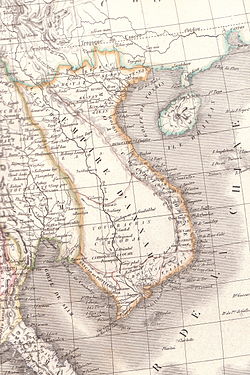
Pro-Thai and pro-Vietnamese factions within the Cambodian court continued to feud. When a pro-Siamese ruler got crowned, anti-Vietnamese violence sparked, and when a pro-Vietnamese was installed, anti-Thai mobs attacked Siamese residents. By 1813, Emperor Gia Long of Vietnam invaded Cambodia and put the Khmer monarchy under Vietnamese protection. The Vietnamese used Cambodians as cheap workers to construct canals and citadels, which later was recalled by the Khmer Rouge anti-Vietnamese propaganda (ironically, the Rouge originated from a Vietnamese communist party). 20 years later, Gia Long's successor, Minh Mang, fully annexed Cambodia and turned it into a Vietnamese province. Minh Mang forced the Cambodians to adopt Vietnamese culture and fashion, including the áo dài. Cambodia disappeared on the world map for 15 years until the Cambodians revolted and Cambodia regained independence from weakening Vietnam in 1848, ending 35-years of Vietnamese occupation.[12]
French rule (1863-1953)[edit]
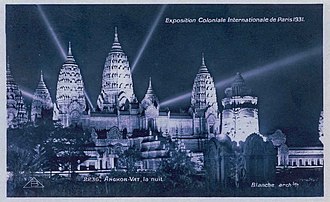
To save Cambodia from domination by its regional enemies, the king of Cambodia undertook one last desperate act of independence in 1863 and met with officials from France to request protection.[13] Although they initially preserved Cambodia's independence, the French gradually modified the deal to exert more and more control. Of course, the French didn't care about Cambodia's welfare any more than the Thai or Vietnamese. To appease the two regional powers and ensure they didn't interfere with French rule, France agreed in 1867 to hand off a lot of Cambodian land to them, reducing Cambodia's borders even further.[14]
The Cambodian king wasn't terribly happy with that, but that didn't stop the French from continuing to erode his power. By 1884, the French had decided that he was a bit too big for his britches, so French "diplomats" showed up with some gunboats to present the king an ultimatum demanding the abolition of slavery, permission for French citizens to own land in Cambodia, and allowance for extensive French settlement in Cambodia's cities.[14] The king reluctantly signed because he had no choice, but nobles and elites rose up to rebel against the abolition of slavery.

In 1887, France clumped Cambodia with Vietnam and Laos to form French Indochina. French officials became responsible for administering Cambodia's government, but Cambodians were even excluded from low-level jobs as the French preferred to hire Vietnamese.[15] The French also decided that Cambodia wasn't worth a lot as a colony, so they shifted their attention elsewhere and did nothing to improve Cambodia's village-based economy.[16] Since development and natural resources were ruled out, the French just decided to hike up taxes on the Cambodian people. Since the Cambodians outwardly seemed nice and easygoing, the French authorities fooled themselves into thinking that the Cambodians were too lazy to pose any threat to them. That turned out to be fiction, as Cambodians became desperate over time and eventually revolted in 1925 to kill a bunch of French tax collectors.
The French finally decided to give a shit, and they commissioned a study of conditions in Cambodia. They found that high tax rates and high interests charged on debt had caused a rash of foreclosures.[16] The report made the French realize that they at least had to do something to improve conditions, so they spent the rest of the 1920s building roads and encouraging the cultivation of rubber trees. Unlike Vietnam and Laos, Cambodia remained relatively docile under French rule during this period.[17] Nonetheless, Cambodian elites were educated under the French, and their national pride was reawakened when the French allowed them to start restoring the ancient Khmer Empire temples. Nationalist reawakening also contributed to Cambodian hatred towards Vietnamese immigrants, who the Cambodians blamed for their lack of economic opportunity.[17] During World War II, Cambodians were also influenced by the Japanese, as they showed up and portrayed themselves as liberators calling for "Asia for the Asiatics". Towards the end of the war, Japan even encouraged Cambodia's king to declare independence. The king actually did so, but he was soon after arrested by the reestablished French government for collaborating with the Axis.
Independence and monarchy[edit]

Cambodia held its first free elections in 1946 under the watchful eye of the French, and this election brought the Cambodian Democratic Party into power.[18] The French weren't too happy with this outcome since the Democrats wanted to push the French out of Cambodia and declare independence. To undo the elections, the French encouraged and supported Cambodia's king Nodorom Sihanouk in launching a 1952 coup against the elected government and seizing power for himself.[19] The French mistakenly thought that the young monarch would be easy to control. However, the king immediately set out on an international publicity tour to win support for his country's independence.[18]
In 1953, Sihanouk returned to find that colonial authorities weren't moved by his show of international solidarity, so the king undertook what he called the "Crusade for Independence." The political struggle went on, but the king was saved by the bell, so to speak. The French war against anti-colonial rebels in Vietnam started going south on them, and the French decided that it was better to cave in the negotiations than face an unwinnable war on two fronts.[18] Cambodia became de facto independent in 1953, and this arrangement became official when France signed the 1954 Geneva Accords that ended the first round of Indochina wars.
Although this peaceful end to colonialism was a pretty good outcome for Cambodia, it certainly didn't bring about any more of a democratic government. The king of Cambodia had come to power by usurping elected authorities, and he wasn't interested in yielding that power. His push for independence had been a giant exercise in demonstrating his royal power and influence. Although he officially had to hold elections as stipulated by the Geneva Conference, that didn't mean that the king needed to play fair. He formed his own party composed of a strange alliance of right-wingers, xenophobic leftists (future Khmer Rouge leaders), and fanatically religious Buddhists.[20] He also sent in soldiers to beat the shit out of Democratic supporters, and by 1957 the only opposition party had dissolved.
US secret bombing of Cambodia[edit]

“”[Nixon] wants a massive bombing campaign in Cambodia. He doesn't want to hear anything. It's an order, it's to be done. Anything that flies on anything that moves.
|
| —Henry Kissinger to Gen. Alexander Haig.[21] |
In terms of foreign policy, Cambodia and its king were stubbornly neutral. This stance stemmed from Cambodia's long history of being oppressed by foreign powers. While the king was no communist, he also wasn't too fond of the idea of joining up for Team America alongside Cambodia's old enemies Thailand and (South) Vietnam.[22]
A few developments started to test that neutrality. In South Vietnam, war broke out between communists and the US-backed authoritarian-right regime. Cambodia began to see troops from both sides go tromping across their border to hide from or pursue each other.[22] US planes also repeatedly ignored Cambodia's right to sovereign air space, which eventually caused relations between the two countries to break down in 1963.[22] That didn't help Cambodia maintain neutrality, as the Vietnamese communists built their Ho Chi Minh Trail through Cambodia, and the loss of US foreign aid could not be replaced by other sources. By 1967, king Sihanouk quietly mumbled that he would stop objecting when the US chased communists into his borders.[23]

Then things got really bad.
In 1969, US President Richard Nixon, on the advice of Henry Kissinger, authorized a secret bombing campaign against Ho Chi Minh rebels in Cambodia.[24] And when we say secret, we mean secret. Nixon insisted that the campaign had to be kept secret from Congress, checks and balances be damned.[25] The United States president thus ordered bombs to be dropped on a neutral country and hid it from both the legislature and the US public. Missions were briefed and launched as strikes against targets in South Vietnam, but the B-52s were redirected in flight to different targets nearby in Cambodia.[25] Records containing the truth were destroyed. Kissinger called the practice "double bookkeeping" in his memoirs.[25]
Despite being kept from the US public, the bombing campaign was pretty fucking obvious to the Cambodian public. Depending on whose numbers you use, US bombs killed between 50,000 and 150,000 Cambodian civilians and caused enormous damage.[21] That lower number, by the way, comes from everyone's favorite Henry Kissinger. The bombing campaign also caused mass chaos in Cambodia, destroying its economy and encouraging peasant uprisings.[26]
In that atmosphere of fear and anger, Pol Pot and the Khmer Rouge began capitalizing on the situation to foment an uprising against the king of Cambodia. One of their main propaganda themes was anti-Americanism and the damage caused by the bombings. Their forces grew from 10,000 in 1969 to 200,000 in 1973.[21] The bombing campaign ordered by Nixon and Kissinger directly created the conditions necessary for the Khmer Rouge to rise.
US invasion of Cambodia[edit]
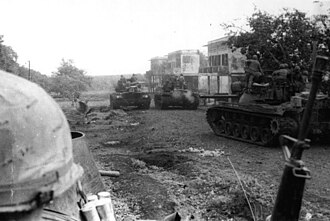
In early 1970, things got even worse. The US, by this point, considered king Sihanouk an enemy because he had initially tolerated Vietnamese communist presence on his soil; this was although the king later allowed the US to bomb his country. The US heavily encouraged Cambodia's prime minister and otherwise total nobody, Lon Nol, to seize power while the king was abroad.[27] Whether or not the US directly aided the coup (that's still disputed), the Nixon administration welcomed Lon Nol's rise to power and likely knew about the coup in advance without telling anyone.[27]
The king didn't take that lying down, and he fled to China to begin making radio broadcasts calling for an anti-government uprising. Lon Nol proved to be utterly incapable of managing anything, and appeared to be going for the record for sheer incompetence among world leaders.[28] This only ended up helping the Khmer Rouge. The prime minister's loyal army responded with extreme violence to protests, and the Khmer Rouge decided that they needed a bit of help to complete their takeover. They requested aid from North Vietnam, which indeed came to aid their fellow communists.[29] Nixon decided that he had to stop any communist takeover of Cambodia, so he ordered US troops into Cambodia. His televised address defending that decision met nationwide protests, which became violent when the Ohio National Guard shot at peaceful protesters at Kent State University, killing four.[30]
Although the US offensive successfully pushed the Vietnamese back out of Cambodia, the campaign didn't do much to harm the Khmer Rouge. It gave Pol Pot the last propaganda tool he needed to spark a full country-wide anti-government uprising.[31] Lon Nol was ridiculously ineffective at even the most basic facets of governing, so once the US withdrew from Cambodia and the wider Vietnam War in 1973, the Khmer Rouge rapidly seized control of Cambodia's countryside.
Khmer Rouge rule and genocide[edit]

Khmer Rouge atrocities began almost as soon as the US left and gave them their opportunity to really go on the offensive. The countryside under their control was reorganized into a harsh regime called the Angkar Loeu (High Organization). People were encouraged to spy on each other and loudly express hate for all foreigners or face severe punishment.[32] When the Khmer Rouge captured its first major city, it topped itself with an even bigger set of atrocities. They destroyed the entire city of Odongk, dispersed its 20,000 residents into the countryside, and shot all of the educated people.[32] While the Vietnamese communists were concerned with winning the support of the people, the Khmer Rouge just inflicted indiscriminate terror on everyone. They offered people the choice between obedience and a miserable life or cruel and painful death.
The Khmer Rouge was inspired by the philosophy of Mao Zedong (and partly Stalin) and hoped to transform Cambodia into an agrarian, one-party, Medieval society.[33] They believed that returning Cambodia to its past was the key to restoring the greatness it had during the Khmer Empire. That idea was obviously stupid. Still, their opponents were gradually terrified into silence. By 1975, they had captured Phnom Penh, and the prime minister fled into exile rather than face certain death at the hands of the Khmer Rouge.[34]
Back in the US, Henry Kissinger advised Nixon to offer the new regime friendship in the hopes that they could serve as a counter-balance to communist Vietnam.[21] The Khmer Rouge ignored that overture and retreated into total xenophobic isolationism. While the US extended a shaky hand of friendship, the Khmer Rouge began mass-executing everyone who had opposed their rise to power.[35] Then the Khmer Rouge started destroying anything that reminded them of the old order. Selling anything or talking to a foreigner was an act of treason, and perpetrators were sent to "re-education camps" to be tortured to death.[35] They also targeted other people they didn't like, such as religious and racial minorities and "intellectuals" (i.e., people that wear glasses or could read and write) who they figured were poisoned by foreign ideals.[36] People were escorted outside of their homes into "killing fields" and beaten or stabbed to death with spades, bamboo sticks, or farming implements.[35][37] The Khmer Rouge also killed children and babies by beating them against trees to prevent them from growing up and becoming future enemies.[38]
Survivors didn't fare too much better since the Khmer Rouge sentenced them to work in brutal forced labor gangs. And they could still end up murdered anyways for "crimes" like not working hard, complaining about living conditions, collecting or stealing food for personal consumption, wearing jewelry, having unauthorized sexual relations, grieving over the loss of relatives or friends, or for expressing religious sentiments.[39] They also eliminated sick and disabled people because when you've already gone this far, why the fuck not? While Norodom Sihanouk was never outright tortured he remained under house arrest the entire time, first at his palace and then in some random apartment outside the capital; while far less brutal than what almost anyone else endured, given how pretty much everyone responded to mere months of COVID-19 lockdowns it can be inferred that 3+ years of it would have been a lot for almost anyone to handle.
Also, the fabulous temples built by the Khmer Empire? Most of those were destroyed during the Khmer Rouge's crackdown on religion, and many could not be rebuilt.[40] They also killed just about every practitioner of traditional Cambodian music, a loss from which modern Cambodian culture is still desperately trying to recover; for instance, only one kse diev![]() player of any note, Sok Duch, somehow managed to survive.
player of any note, Sok Duch, somehow managed to survive.
Invasion and occupation by Vietnam[edit]

The Khmer Rouge sowed the seeds of its own downfall from the very beginning. When it came to power in 1975, it immediately became hostile to its neighbors and historical enemies, Thailand and Vietnam, and violent border clashes along the border with Vietnam rapidly escalated into an undeclared war.[41] Thousands of civilians died on the Vietnamese side, and the Vietnamese always hoped that striking back would teach the goddamn Cambodians a lesson. That didn't work because even when the Khmer Rouge lost engagements, Pol Pot would announce a great victory. Pol Pot had a tenuous grasp on reality.

When the Cambodians retaliated by stepping up their massacres of ethnic Vietnamese, the communist Vietnamese government finally decided that enough was enough. In 1978, Vietnam launched a full-scale anti-genocidal invasion of Cambodia, seeking to oust the Khmer Rouge, marking the beginning of the first and only extended war between communist regimes.[42] The Vietnamese faced a similar situation as the Americans before them, dealing with a brutal enemy that used guerrilla tactics to whittle away their numbers and morale. War veteran Nguyen Thanh Nhan says, "Anyone who came back from Cambodia intact was a lucky person."[43]
Far from being grateful to the Vietnamese, the Cambodian civilians were furious at once again being occupied by their hated historical enemies. Pol Pot fled into the countryside with his followers to wage a protracted bush war against the Vietnamese occupiers. The government of Thailand had its own historical grudge to nurse against Vietnam and made it abundantly clear that they would only allow Cambodian relief to the Khmer Rouge; since the United States also still considered Vietnam an enemy, the American government spent tens of millions of dollars aiding Khmer Rouge rebels.[21] The US also provided the Khmer Rouge with diplomatic cover by denying that they had committed genocide and helping suppress evidence of their crimes. When the Vietnamese-backed "People's Republic of Kampuchea" sued the United Nations for control of the Cambodia UN seat, the US decided to support Pol Pot's claim against them.[44]
Facing a civil war, rampant corruption, and a desperate lack of resources, the new Cambodian regime only survived thanks to its Vietnamese backers' prolonged program of aid and military assistance.[41] Thanks to the Thai-backed Khmer Rouge insurgency, Cambodia spent the 1980s in a permanent state of insecurity. The Cambodian government used its few available resources to try and painstakingly build Cambodia's economy from nothing. Even though the Vietnamese were hated, their invasion and occupation made Cambodia much better off than they were under the Khmer Rouge. Vietnam opened Cambodia's records to reveal the Khmer Rouge's crimes, and they helped Cambodia join the Soviet Bloc and get aid from other communist countries.
Modern Cambodia[edit]
In 1991, the hostilities with Vietnam came to an end. The Paris Peace Agreements saw Vietnam withdraw from Cambodia, and saw the UN take over and begin preparing Cambodia to stand on its own as a government.[45] While working out a new constitution, most of Cambodia's leading political factions agreed that the monarchy should be restored and that the king should be able to mediate their disagreements.[46]
In 1997, the Cambodian People's Party and its leader Hun Sen led a coup that killed about 100 people and established effective one-party rule.[47] Even though Hun Sen was a former Khmer Rouge fighter and even though the party ruled the communist Cambodian government during the era of Vietnamese occupation, it is today a socially conservative and free-market capitalist party under Hun Sen's leadership.[48] Hun Sen has been prime minister ever since. His administration has been accused of many human rights violations and (in keeping with Khmer tradition) insane amounts of corruption. The main opposition leader, Sam Rainsy, has repeatedly had to flee the country due to persecution. Still, while he has explicitly campaigned against the insanely oppressive and corrupt regime of Hun Sen, it is not at all clear his leadership would be a meaningful improvement.
Government[edit]
“”To call for any sort of change is painted as an attempt to destroy the achievement of the past three decades and return to the cauldron of bloodshed and violence. When the liberation happened, it triggered a mass flight into what’s familiar — into tradition, into Buddhism, into conservatism, a very risk-averse view of politics.
|
| —Sebastian Strangio, journalist on Southeast Asian affairs.[49] |
Monarchy[edit]
The current reigning house in Cambodia claims descent from the ancient monarchs of the Khmer Empire, and this was apparently confirmed by French scholars.[50] Although his powers are limited, he's a revered figure in Cambodian society, and his opinions carry weight with the government. For instance, in 2004, the king made his opinion known that Cambodia should legalize gay marriage and treat transgender people better, and the very conservative Cambodian government took him seriously.[51] Parts of Cambodia have since then offered a limited form of recognition for same-sex couples.[52]
Unlike most monarchies, the Cambodian throne does not have its successor chosen by ordinary hereditary succession. The king (and the current one maintains he intends to remain happily unmarried and childless) may not choose his successor either. Instead, a Royal Council of the Throne, which includes the president of the National Assembly and the Prime Minister, selects the new king from a pool of candidates who have "royal blood".[50] Cambodia also has a vaguely-worded law that criminalizes the act of "insulting the king".[50]
Prime Minister[edit]
The real power lies with the prime minister. Former Prime Minister Hun Sen was a hardliner, and his party's influence is a defining factor in Cambodian politics.[49] He maintains his power by arresting the leaders of any notable opposition parties and by stoking fears that his political downfall would return Cambodia to a state of civil war.[53] He pledged in 2018 to stay in power for at least 10 more years. Things changed when he handed over his power to his son Hun Manet in 2023 although he remains influential in the government.
Human rights[edit]
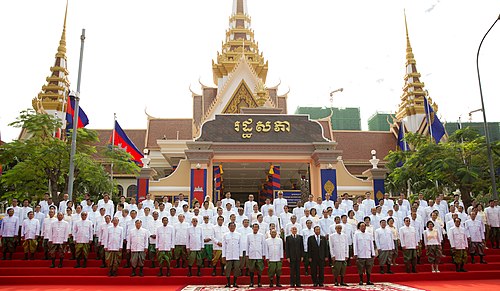
Freedom of speech and association[edit]
Cambodia's human rights deteriorated rapidly after the 2018 elections re-confirmed Hun Sen's rule. The election was condemned as a sham by international observers, as it took place after Hun Sen launched a months-long crackdown against the opposition.[54] Hun Sen had opposition candidates arrested arbitrarily, and his rubber-stamp Supreme Court ordered the main opposition party to dissolve before voters went to the polls.[55] That election fully transformed Cambodia into a one-party state.
Since then, a slew of new legislation has given authorities and the prime minister broad authority to have people arrested on vague charges. Since then, Cambodia's free speech status has become much worse as people have been arrested for speaking out.[56]
Hun Sen's government also shut down Cambodia's press outlets one by one, and the last independent outlet was recently sold off to a Malaysian businessman who wanted to avoid making trouble with the Cambodian government.[57] Hun Sen has also recently submitted anti-"fake news" and extensive surveillance bills to the National Assembly.[56]
LGBT rights[edit]
Cambodia is a bit better but certainly not perfect when it comes to LGBT rights. As detailed above, the Cambodian king made comments urging the government to be more accepting of gay and transgender people.[51] Same-sex marriage has entered into a tenuous legal state where it's not quite outlawed but also not quite recognized.
Unfortunately, according to the US Agency for International Development, LGBT Cambodians still face discrimination and emotional, sexual, and physical abuse.[58] A 2012 survey found that 65% of Cambodian men would support legislation to protect LGBT Cambodians, and the Ministry of Information and the Ministry of Women's Affairs have both started media campaigns to combat LGBT discrimination.[58]
Pseudohistory[edit]
.jpg)
Angkor "dinosaur"[edit]
As evidence that humans and dinosaurs existed simultaneously and that the earth could be young, creationists present a carving found among the ruins near Siem Reap in Cambodia that they claim is of a stegosaurus. The kids there call it their approximation of a dinosaur, dee no soo. Answers in Genesis has concluded, "That means that only a little over 800 years ago, some dinosaurs were likely still living in the region of Cambodia!" They also assert that "we know from Genesis 1 that land animals (such as dinosaurs) and humans were living together in the beginning, and that representatives of the land animals (e.g., dinosaurs) were saved on the Ark to repopulate the earth after the Flood only 4,300 years ago."[59] The drawing, of course, depicts something else entirely: among other things, the "stegosaurus" is shown as having long ears. It is either a drawing of a modern animal such as a rhinoceros or a modern hoax.[60]
Gallery[edit]
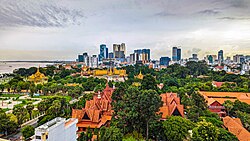
Skyline of Pnom Penh, Cambodia's capital.
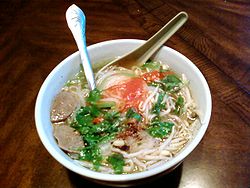
Cambodian rice noodle soup.

Enjoying a Cambodian waterfall.
Cambodian classical dancers.
- Pchum Ben Khmer.png
Celebrating the Buddhist Pchum Ben Festival.
See also[edit]
- Burma
- Laos
References[edit]
- ↑ Anthony Bourdain. Wikiquote.
- ↑ See the Wikipedia article on Religion in Cambodia.
- ↑ See the Wikipedia article on Royal Council of the Throne.
- ↑ Higham, Charles (January 2002). The civilization of Angkor. Phoenix. ISBN 978-1-84212-584-7., pp.13–22
- ↑ 5.0 5.1 Early Indianized Kingdom of Funan. Country Studies.
- ↑ 6.0 6.1 6.2 6.3 6.4 6.5 6.6 Angkorian Period. Country Studies.
- ↑ Angkor Wat. National Geographic.
- ↑ Metropolis: Angkor, the world's first mega-city. The Independent.
- ↑ See the Wikipedia article on Theravada.
- ↑ 10.0 10.1 10.2 Cambodia's Struggle For Survival. Country Studies.
- ↑ Peter Church (2012). A Short History of South-East Asia. John Wiley & Sons. p. 24. ISBN 978-1-118-35044-7.
- ↑ Cambodia: Domination by Thailand and by Vietnam. Country Studies.
- ↑ Norman G. Owen (2005). The Emergence Of Modern Southeast Asia: A New History. University of Hawaii Press. pp. 117–. ISBN 978-0-8248-2890-5.
- ↑ 14.0 14.1 Cambodia: The French Protectorate. Country Studies.
- ↑ French Colonial Period. Country Studies.
- ↑ 16.0 16.1 Cambodia: Colonial Economy. Country Studies.
- ↑ 17.0 17.1 Cambodia: Emergence of Nationalism. Country Studies.
- ↑ 18.0 18.1 18.2 How King Sihanouk Brought French Rule to a Peaceful End. Cambodia Daily.
- ↑ Kamm, Henry (1998). Cambodia: report from a stricken land. New York: Arcade Publishing. p. 27. ISBN 1-55970-433-0.
- ↑ Cambodia: Domestic Developments. Country Studies.
- ↑ 21.0 21.1 21.2 21.3 21.4 Nixon and the Cambodian Genocide. Jacobin.
- ↑ 22.0 22.1 22.2 Nonaligned Foreign Policy. Country Studies.
- ↑ Morris, Stephen J. (1999). Why Vietnam Invaded Cambodia. Stanford University Press. ISBN 0804730490. p. 44
- ↑ Bombing of Cambodia. Ohio History Central.
- ↑ 25.0 25.1 25.2 The Shadow War in Cambodia. Air Force Magazine.
- ↑ ROOTS OF GENOCIDE: NEW EVIDENCE ON THE US BOMBARDMENT OF CAMBODIA. Cultural Survival Quarterly Magazine.
- ↑ 27.0 27.1 Lon Nol coup marked. Pnom Penh Post.
- ↑ Kiernan, Ben (2004). How Pol Pot Came to Power: Colonialism, Nationalism, and Communism in Cambodia, 1930–1975. Yale University Press. p. 300. ISBN 9780300102628.
- ↑ See the Wikipedia article on Cambodian campaign.
- ↑ Nixon authorizes invasion of Cambodia, April 28, 1970. Politico.
- ↑ See the Wikipedia article on Cambodian campaign.
- ↑ 32.0 32.1 Early Khmer Rouge Atrocities. Country Studies.
- ↑ Origins of the Khmer Rouge. US Holocaust Memorial Museum.
- ↑ The Fall of Phnom Penh. Country Studies.
- ↑ 35.0 35.1 35.2 33 Haunting Photos From The Killing Fields Of The Cambodian Genocide. All Thats Interesting.
- ↑ Cambodia. University of Minnesota, "Holocaust and Genocide Studies".
- ↑ See the Wikipedia article on Killing Fields.
- ↑ Khmer Rouge Baby-Killing Recalled In Court. CBS News.
- ↑ Democratic Kampuchea. Country Studies.
- ↑ Kevin Baker (3 November 2014). The Worst World Disasters of All Time. p. 23. ISBN 9781456623432.
- ↑ 41.0 41.1 The Fall of Democratic Kampuchea. Country Studies.
- ↑ Why Vietnam Invaded Cambodia. Stanford University Press.
- ↑ Vietnam's forgotten Cambodian war. BBC News.
- ↑ U.S. to Support Pol Pot Regime For U.N. Seat. Washington Post. 1980.
- ↑ See the Wikipedia article on 1991 Paris Peace Agreements.
- ↑ Cambodian leaders agree on restoration of monarchy. United Press International.
- ↑ Cambodian Opposition Marks 1997 Coup. Voice of America.
- ↑ See the Wikipedia article on Cambodian People's Party.
- ↑ 49.0 49.1 40 Years After the Fall of the Khmer Rouge, Cambodia Still Grapples With Pol Pot's Brutal Legacy. TIME.
- ↑ 50.0 50.1 50.2 Monarchy of Cambodia. Facts and Details.
- ↑ 51.0 51.1 King Lends Support to Same Sex Marriages. Cambodia Daily.
- ↑ See the Wikipedia article on Recognition of same-sex unions in Cambodia.
- ↑ Hun Sen: Cambodia's strongman prime minister. BBC News.
- ↑ Cambodia: Hun Sen re-elected in landslide victory after brutal crackdown. The Guardian.
- ↑ Cambodia Is Becoming 'Openly Authoritarian' in Its Crackdown on Opposition. TIME.
- ↑ 56.0 56.1 Cambodia Report 2020. Human Rights Watch.
- ↑ The Sale of Cambodia's Last Independent Newspaper Pushes Press Freedom Into Peril. TIME.
- ↑ 58.0 58.1 LGBT Campaigner Calls for Legal Protections. Voice of America.
- ↑ Cole, Kenneth E. (Jan. 15, 2007). "Evidence of dinosaurs at Angkor." Answers in Genesis.
- ↑ "Stegosaurus, Rhinoceros, or Hoax?" at Smithsonianmag.com "http://blogs.smithsonianmag.com/dinosaur/2009/03/stegosaurus-rhinoceros-hoax/"
Categories: [Asian countries] [Southeast Asia] [Authoritarian regimes] [Anti-Western] [History of communism] [Communism] [Genocide] [Racism] [Sexism] [Homophobia] [Pissed at us]
↧ Download as ZWI file | Last modified: 11/05/2025 06:48:23 | 97 views
☰ Source: https://rationalwiki.org/wiki/Cambodia | License: CC BY-SA 3.0
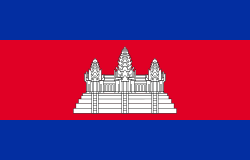
.JPG)
 KSF
KSF